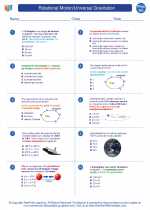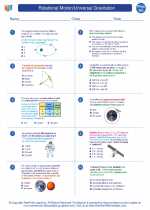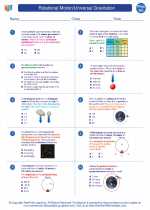Rotational Motion/Universal Gravitation
Rotational motion and universal gravitation are essential topics in physics. Understanding these concepts is crucial for comprehending the behavior of objects in motion and the forces that govern them. Here is a study guide to help you master these topics:
Rotational Motion
Rotational motion refers to the movement of an object around an axis. Here are some key concepts to understand:
Rotational Kinematics
Rotational kinematics deals with the motion of objects that are rotating. It involves quantities such as angular displacement, angular velocity, and angular acceleration. The equations of linear motion have their rotational counterparts in terms of angular quantities.
Moment of Inertia
The moment of inertia, denoted by 'I', is a measure of an object's resistance to changes in its rotation speed. It depends on the mass and distribution of mass of the object. For a point mass, the moment of inertia is given by I = mr2, where 'm' is the mass and 'r' is the distance from the axis of rotation.
Torque
Torque is the rotational equivalent of force. It is the measure of the force that can cause an object to rotate about an axis. Mathematically, torque (τ) is given by τ = rFsin(θ), where 'r' is the distance from the axis of rotation, 'F' is the force applied, and θ is the angle between the force and the lever arm.
Universal Gravitation
Universal gravitation is the force of attraction between all objects with mass. This concept was first formulated by Sir Isaac Newton and is described by the following key points:
Law of Universal Gravitation
The law of universal gravitation states that every point mass in the universe attracts every other point mass with a force that is directly proportional to the product of their masses and inversely proportional to the square of the distance between their centers. Mathematically, the force of gravity (F) between two objects is given by F = G(m1m2)/r2, where 'G' is the gravitational constant, 'm1' and 'm2' are the masses of the objects, and 'r' is the distance between their centers.
Gravitational Field
The gravitational field around an object is the region in which another object experiences a gravitational force. The strength of the gravitational field is inversely proportional to the square of the distance from the object's center. The gravitational field is a vector quantity, and its direction is towards the center of the mass causing the field.
Gravitational Potential Energy
Gravitational potential energy is the energy an object possesses due to its position in a gravitational field. It is given by U = mgh, where 'm' is the mass of the object, 'g' is the acceleration due to gravity, and 'h' is the height of the object above a chosen reference point.
Understanding rotational motion and universal gravitation is crucial for solving problems related to motion and forces. Practice applying the relevant equations and concepts to various scenarios to solidify your understanding.
Good luck with your studies!
.◂Physics Worksheets and Study Guides High School. Rotational Motion/Universal Gravitation

 Worksheet/Answer key
Worksheet/Answer key
 Worksheet/Answer key
Worksheet/Answer key
